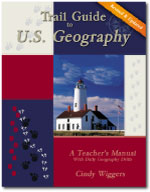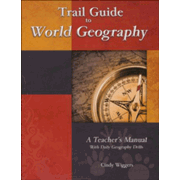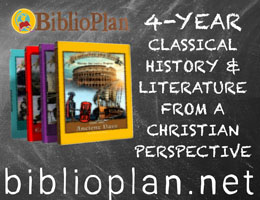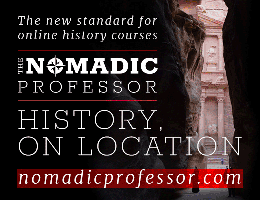Trail Guides can be used to teach geography to children in grades 2 through 12. The series of three Guides cover United States, World, or Biblical geography, respectively. Each volume is set up to address students at three different levels. This means that each volume can then be "reused" for up to three years of geography study as students move from level to level. Generally, you would not use the same book two years in a row, but would shift to another book, returning to a book a year or two later.
Trail Guides differ greatly from traditional textbooks since they use a discovery-inquiry approach with lots of activities. Students will need an appropriate atlas for much of their research. For example, for Trail Guide to World Geography, the youngest students should use the Junior Classroom Atlas or something comparable. Intermediate students might use the Classroom Atlas, while high school students might use the Answer Atlas and an almanac.
All students begin each of the first four days' sessions by searching out answers to two questions (different questions for each level). Some families might choose to do nothing more than work on these "Geography Trail" questions for their geography studies. But there's much more in the Trail Guides for those looking to go deeper.
The "Points of Interest" section of each lesson offers a plethora of learning activities. You should choose from these according to the ages and needs of your students as well as time available.
The first of the Points of Interest are mapping activities: locating, labeling, drawing maps, or shading in areas of maps. You will likely want to purchase one of the companion LapBook CD-ROMs for your Trail Guide since these have maps and reproducibles needed for these activities. If you have another resource such as Uncle Josh's Outline Maps, that will do. Trail Guide LapBook CD-ROMs are available only through the publisher.
"Trail Blazing" activities come next under "Points of Interest," and this is where you move into projects, activities, and research. Students might research the Panama Canal and write a report; play a geography Concentration game; watch travel videos; create a crossword puzzle; find recipes for foods from the area being studied and do some cooking; etc.
"Geography Notebook" is the next option. Students create more maps and charts; do further research on climate, land usage, population, etc; and study and/or report on landmarks, animals, products, or other highlights of a state, country, or region. The optional CDs prove especially valuable for this section since they include many reproducibles for notebook creation.
The "Geography through Art" section lists suggested art and craft projects.
If all this isn't enough to keep you busy, each Guide includes a multi-week, literature-based unit study. Around the World in 80 Days is the book studied in the Trail Guide to World Geography. The Captain's Dog (about the Lewis and Clarke expedition) is used in the Trail Guide to U.S. Geography. And The Bronze Bow is used in the Bible Guide. These unit studies include activities such as those already listed as well as chapter-by-chapter discussion questions and spelling and vocabulary words.
While the Trail Guides present lots of activity suggestions, those for which there are no reproducibles generally require you to use other resources. I already mentioned the atlases and almanac. The Ultimate Geography and Timeline Guide should be another useful reference/activity resource. If you tackle Trail Blazing, Geography Notebook, Geography through Art, and literature study sections, you will also need ready access to the internet or a library if you don't have a huge home library for some of the other research activities. No websites are given so you will need to research sites on your own. Eat Your Way across the U.S.A. and Eat Your Way around the World (both from Geography Matters) might be very useful for those interested in recipes and cooking. No directions are provided for art activities. Some can be found in the book Geography through Art by Sharon Jeffus, Rich Jeffus, and Cindy Wiggers, but those not artistically inclined might feel at a loss as to how to do a suggested activity.
All of this means that the Trail Guides are great for parents who love to locate and pull together resources and have the time to sort out which activities to use for each age student. Parents who prefer fully developed lesson plans and everything provided in one place will likely feel overwhelmed if they venture past the "Geography Trails" sections.
I think the Trail Guides should work best used selectively alongside U.S. or World History studies done with other resources. The Trail Guide to Bible Geography could be used similarly alongside other Scripture study. The literature units might be great for use over the summer if you don't have time during the school year.
The publisher sells bundles of key resources needed for each guide; check their website for details.













